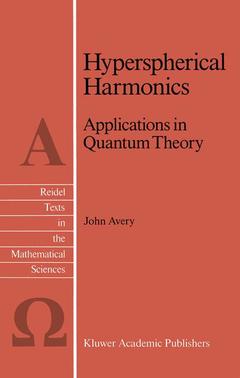Description
Hyperspherical Harmonics, Softcover reprint of the original 1st ed. 1989
Applications in Quantum Theory
Reidel Texts in the Mathematical Sciences Series, Vol. 5
Author: Avery John S.
Language: English
Subject for Hyperspherical Harmonics:
Approximative price 158.24 €
In Print (Delivery period: 15 days).
Add to cart
Publication date: 01-2012
256 p. · 15.5x23.5 cm · Paperback
256 p. · 15.5x23.5 cm · Paperback
Description
/li>Contents
/li>
where d 3 3)2 ( L x - -- i3x j3x j i i>j Thus the Gegenbauer polynomials play a role in the theory of hyper spherical harmonics which is analogous to the role played by Legendre polynomials in the familiar theory of 3-dimensional spherical harmonics; and when d = 3, the Gegenbauer polynomials reduce to Legendre polynomials. The familiar sum rule, in 'lrlhich a sum of spherical harmonics is expressed as a Legendre polynomial, also has a d-dimensional generalization, in which a sum of hyper spherical harmonics is expressed as a Gegenbauer polynomial (equation (3-27»: The hyper spherical harmonics which appear in this sum rule are eigenfunctions of the generalized angular monentum 2 operator A , chosen in such a way as to fulfil the orthonormality relation: VIe are all familiar with the fact that a plane wave can be expanded in terms of spherical Bessel functions and either Legendre polynomials or spherical harmonics in a 3-dimensional space. Similarly, one finds that a d-dimensional plane wave can be expanded in terms of HYPERSPHERICAL HARMONICS xii "hyperspherical Bessel functions" and either Gegenbauer polynomials or else hyperspherical harmonics (equations ( 4 - 27) and ( 4 - 30) ) : 00 ik·x e = (d-4)!!A~oiA(d+2A-2)j~(kr)C~(~k'~) 00 (d-2)!!I(0) 2: iAj~(kr) 2:Y~ (["2k)Y (["2) A A=O ). l). l)J where I(O) is the total solid angle. This expansion of a d-dimensional plane wave is useful when we wish to calculate Fourier transforms in a d-dimensional space.
Harmonic polynomials.- Generalized angular momentum.- Gegenbauer polynomials.- Fourier transforms in d dimensions.- Fock’s treatment of hydrogenlike atoms and its generalization.- Many-dimensional hydrogenlike wave functions in direct space.- Solutions to the reciprocal-space Schrödinger equation for the many-center Coulomb problem.- Matrix representations of many-particle Hamiltonians in hyper spherical coordinates.- Iteration of integral forms of the Schrödinger equation.- Symmetry-adapted hyperspherical harmonics.- The adiabatic approximation.- Appendix A: Angular integrals in a 6-dimensional space.- Appendix B: Matrix elements of the total orbital angular momentum operator.- Appendix C: Evaluation of the transformation matrix U.- Appendix D: Expansion of a function about another center.- References.
© 2024 LAVOISIER S.A.S.



